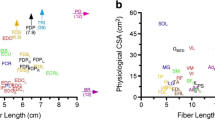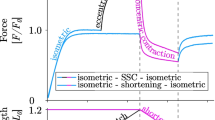Abstract
The collagenous extracellular matrix (ECM) of skeletal muscle functions to transmit force, protect sensitive structures, and generate passive tension to resist stretch. The mechanical properties of the ECM change with age, atrophy, and neuromuscular pathologies, resulting in an increase in the relative amount of collagen and an increase in stiffness. Although numerous studies have focused on the effect of muscle fibrosis on passive muscle stiffness, few have examined how these structural changes may compromise contractile performance. Here we combine a mathematical model and experimental manipulations to examine how changes in the mechanical properties of the ECM constrain the ability of muscle fibers and fascicles to radially expand and how such a constraint may limit active muscle shortening. We model the mechanical interaction between a contracting muscle and the ECM using a constant volume, pressurized, fiber-wound cylinder. Our model shows that as the proportion of a muscle cross section made up of ECM increases, the muscle’s ability to expand radially is compromised, which in turn restricts muscle shortening. In our experiments, we use a physical constraint placed around the muscle to restrict radial expansion during a contraction. Our experimental results are consistent with model predictions and show that muscles restricted from radial expansion undergo less shortening and generate less mechanical work under identical loads and stimulation conditions. This work highlights the intimate mechanical interaction between contractile and connective tissue structures within skeletal muscle and shows how a deviation from a healthy, well-tuned relationship can compromise performance.




Similar content being viewed by others
References
Alnaqeeb MA, Alzaid NS, Goldspink G (1984) Connective-tissue changes and physical-properties of developing and aging skeletal-muscle. J Anat 139(DEC):677–689
Astley HC, Roberts TJ (2012) Evidence for a vertebrate catapult: elastic energy storage in the plantaris tendon during frog jumping. Biol Lett 8(3):386–389
Azizi E (2014) Locomotor function shapes the passive mechanical properties and operating lengths of muscle. Proc R Soc B Biol Sci 281(1783):20132914
Azizi E, Brainerd EL, Roberts TJ (2008) Variable gearing in pennate muscles. Proc Natl Acad Sci USA 105(5):1745–1750
Azizi E, Roberts TJ (2010) Muscle performance during frog jumping: influence of elasticity on muscle operating lengths. Proc R Soc B Biol Sci 277(1687):1523–1530
Baskin RJ, Paolini PJ (1967) Volume change and pressure development in muscle during contraction. Am J Physiol 213(4):1025–1030
Bernabei M, van Dieën JH, Baan GC, Maas H (2015) Significant mechanical interactions at physiological lengths and relative positions of rat plantar flexors. J Appl Physiol 118(4):427–436
Biewener AA, Konieczynski DD, Baudinette RV (1998) In vivo muscle force-length behavior during steady-speed hopping in tammar wallabies. J Exp Biol 201(11):1681–1694
Blemker SS, Pinsky PM, Delp SL (2005) A 3D model of muscle reveals the causes of nonuniform strains in the biceps brachii. J Biomech 38(4):657–665
Gao YX, Kostrominova TY, Faulkner JA, Wineman AS (2008) Age-related changes in the mechanical properties of the epimysium in skeletal muscles of rats. J Biomech 41(2):465–469
Gillies AR, Lieber RL (2011) Structure and function of the skeletal muscle extracellular matrix. Muscle Nerve 44:318–331
Gindre J, Takaza M, Moerman KM, Simms CK (2013) A structural model of passive skeletal muscle shows two reinforcement processes in resisting deformation. J Mech Behav Biomed Mater 22:84–94
Gokhin DS, Fowler VM (2013) A two-segment model for thin filament architecture in skeletal muscle. Nat Rev Mol Cell Biol 14(2):113–119
Gosselin LE, Adams C, Cotter TA, McCormick RJ, Thomas DP (1998) Effect of exercise training on passive stiffness in locomotor skeletal muscle: role of extracellular matrix. J Appl Physiol 85(3):1011–1016
Holt NC, Azizi E (2014) What drives activation-dependent shifts in the force-length curve? Biol Lett 10(9):20140651–20140651
Huijing PA (1999) Muscle as a collagen fiber reinforced composite: a review of force transmission in muscle and whole limb. J Biomech 32:329–345
Huijing PA (2007) Epimuscular myofascial force transmission between antagonistic and synergistic muscles can explain movement limitation in spastic paresis. J Electromyogr Kinesiol 17(6):708–724
Huijing PA, Baan GC (2003) Myofascial force transmission: muscle relative position and length determine agonist and synergist muscle force. J Appl Physiol 94(3):1092–1107
Huijing PA, Baan GC, Rebel GT (1998) Non-myotendinous force transmission in rat extensor digitorum longus muscle. J Exp Biol 201(Pt 5):683–691
Huijing PA, van de Langenberg RW, Meesters JJ, Baan GC (2007) Extramuscular myofascial force transmission also occurs between synergistic muscles and antagonistic muscles. J Electromyogr Kinesiol 17(6):680–689
Järvinen TAH, Józsa L, Kannus P, Järvinen TLN, Järvinen M (2002) Organization and distribution of intramuscular connective tissue in normal and immobilized skeletal muscles. An immunohistochemical, polarization and scanning electron microscopic study. J Muscle Res Cell Motil 23(3):245–254
Kier WM (2012) The diversity of hydrostatic skeletons. J Exp Biol 215(Pt 8):1247–1257
Kjaer M (2004) Role of extracellular matrix in adaptation of tendon and skeletal muscle to mechanical loading. Physiol Rev 84(2):649–698
Kjaer M, Magnusson P, Krogsgaard M, Moller JB, Olesen J, Heinemeier K, Hansen M, Haraldsson B, Koskinen S, Esmarck B, Langberg H (2006) Extracellular matrix adaptation of tendon and skeletal muscle to exercise. J Anat 208(4):445–450
Lieber RL, Ward SR (2011) Skeletal muscle design to meet functional demands. Philos Trans R Soc B Biol Sci 366(1570):1466–1476
Lieber RL, Ward SR (2013) Cellular mechanisms of tissue fibrosis. 4. Structural and functional consequences of skeletal muscle fibrosis. Am J Physiol Cell Physiol 305(3):C241–C252
Lynch JE, Lynch JK, Cole SL, Carter JA, Hargens AR (2009) Noninvasive monitoring of elevated intramuscular pressure in a model compartment syndrome via quantitative fascial motion. J Orthop Res 27(4):489–494
Maas H, Huijing PA (2005) Myofascial force transmission in dynamic muscle conditions: effects of dynamic shortening of a single head of multi-tendoned rat extensor digitorum longus muscle. Eur J Appl Physiol 94(5–6):584–592
Maas H, Sandercock TG (2010) Force transmission between synergistic skeletal muscles through connective tissue linkages. J Biomed Biotechnol 2010(1):575672–575679
Meyer GA, Lieber RL (2011) Elucidation of extracellular matrix mechanics from muscle fibers and fiber bundles. J Biomech 44(4):771–773
Pamuk U, Karakuzu A, Ozturk C, Acar B, Yucesoy CA (2016) Combined magnetic resonance and diffusion tensor imaging analyses provide a powerful tool for in vivo assessment of deformation along human muscle fibers. J Mech Behav Biomed Mater 63:207–219
Pappas GP, Asakawa DS, Delp SL, Zajac FE, Drace JE (2002) Nonuniform shortening in the biceps brachii during elbow flexion. J Appl Physiol 92(6):2381–2389
Patel TJ, Das R, Fridén J, Lutz GJ, Lieber RL (2004) Sarcomere strain and heterogeneity correlate with injury to frog skeletal muscle fiber bundles. J Appl Physiol 97(5):1803–1813
Purslow PP (1989) Strain-induced reorientation of an intramuscular connective tissue network: implications for passive muscle elasticity. J Biomech 22(1):21–31
Purslow PP (2002) The structure and functional significance of variations in the connective tissue within muscle. Comp Biochem Physiol A Mol Integr Physiol 133(4):947–966
Purslow PP, Trotter JA (1994) The morphology and mechanical properties of endomysium in series-fibred muscles: variations with muscle length. J Muscle Res Cell Motil 15(3):299–308
Ramaswamy KS, Palmer ML, van der Meulen JH, Renoux A, Kostrominova TY, Michele DE, Faulkner JA (2011) Lateral transmission of force is impaired in skeletal muscles of dystrophic mice and very old rats. J Physiol Lond 589(5):1195–1208
Rassier DE, MacIntosh BR, Herzog W (1999) Length dependence of active force production in skeletal muscle. J Appl Physiol (Bethesda, MD: 1985) 86(5):1445–1457
Roberts TJ, Marsh RL, Weyand PG, Taylor CR (1997) Muscular force in running turkeys: the economy of minimizing work. Science 275(5303):1113–1115
Siebert T, Rode C, Till O, Stutzig N, Blickhan R (2016) Force reduction induced by unidirectional transversal muscle loading is independent of local pressure. J Biomech 49(7):1156–1161
Siebert T, Till O, Blickhan R (2014a) Work partitioning of transversally loaded muscle: experimentation and simulation. Comput Methods Biomech Biomed Eng 17(3):217–229
Siebert T, Till O, Stutzig N, Günther M, Blickhan R (2014b) Muscle force depends on the amount of transversal muscle loading. J Biomech 47(8):1822–1828
Sleboda DA, Roberts TJ (2017) Incompressible fluid plays a mechanical role in the development of passive muscle tension. Biol Lett 13(1):20160630
Smith LR, Barton ER (2014) Collagen content does not alter the passive mechanical properties of fibrotic skeletal muscle in mdx mice. Am J Physiol Cell Physiol 306(10):C889–C898
Smith LR, Lee KS, Ward SR, Chambers HG, Lieber RL (2011) Hamstring contractures in children with spastic cerebral palsy result from a stiffer extracellular matrix and increased in vivo sarcomere length. J Physiol Lond 589(10):2625–2639
Street SF (1983) Lateral transmission of tension in frog myofibers: a myofibrillar network and transverse cytoskeletal connections are possible transmitters. J Cell Physiol 114(3):346–364
Svensson RB, Hassenkam T, Grant CA, Magnusson SP (2010) Tensile properties of human collagen fibrils and fascicles are insensitive to environmental salts. Biophys J 99(12):4020–4027
Trotter JA, Purslow PP (1992) Functional morphology of the endomysium in series fibered muscles. J Morphol 212(2):109–122
Turkoglu AN, Yucesoy CA (2016) Simulation of effects of botulinum toxin on muscular mechanics in time course of treatment based on adverse extracellular matrix adaptations. J Biomech 49(7):1192–1198
Ward SR, Davis J, Kaufman KR, Lieber RL (2007) Relationship between muscle stress and intramuscular pressure during dynamic muscle contractions. Muscle Nerve 36(3):313–319
Weibel E (1981) Stereological methods. vol. 1. Practical methods for biological morphometry. J Microsc 121(1):131–132
Winters TM, Sepulveda GS, Cottler PS, Kaufman KR, Lieber RL, Ward SR (2009) Correlation between isometric force and intramuscular pressure in rabbit tibialis anterior muscle with an intact anterior compartment. Muscle Nerve 40(1):79–85
Wood LK, Kayupov E, Gumucio JP, Mendias CL, Claflin DR, Brooks SV (2014) Intrinsic stiffness of extracellular matrix increases with age in skeletal muscles of mice. J Appl Physiol 117(4):363–369
Yucesoy CA (2010) Epimuscular myofascial force transmission implies novel principles for muscular mechanics. Exerc Sport Sci Rev 38(3):128–134
Yucesoy CA, Emre Arıkan Ö, Ateş F (2012) BTX-A administration to the target muscle affects forces of all muscles within an intact compartment and epimuscular myofascial force transmission. J Biomech Eng 134(11):111002
Yucesoy CA, Koopman BHFJM, Baan GC, Grootenboer HJ, Huijing PA (2003) Effects of inter- and extramuscular myofascial force transmission on adjacent synergistic muscles: assessment by experiments and finite-element modeling. J Biomech 36(12):1797–1811
Yucesoy CA, Maas H, Koopman BHFJM, Grootenboer HJ, Huijing PA (2006) Mechanisms causing effects of muscle position on proximo-distal muscle force differences in extra-muscular myofascial force transmission. Med Eng Phys 28(3):214–226
Zhang C, Gao Y (2014) The role of transmembrane proteins on force transmission in skeletal muscle. J Biomech 47(12):3232–3236
Acknowledgements
The authors are grateful to Dr. Tom Roberts, Dr. Nicole Danos, Dr. Angela Horner, and David Sleboda for insightful conversations. This work has been supported by the National Science Foundation Grant #1436476 and National Institute of Health Grant # AR055295.
Author information
Authors and Affiliations
Corresponding author
Ethics declarations
Conflict of interest
The authors declare no competing interests.
Rights and permissions
About this article
Cite this article
Azizi, E., Deslauriers, A.R., Holt, N.C. et al. Resistance to radial expansion limits muscle strain and work. Biomech Model Mechanobiol 16, 1633–1643 (2017). https://doi.org/10.1007/s10237-017-0909-3
Received:
Accepted:
Published:
Issue Date:
DOI: https://doi.org/10.1007/s10237-017-0909-3




